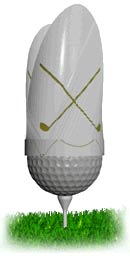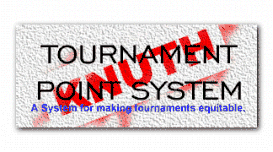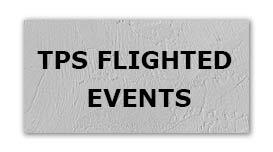|




|
The Jury is Out, but ESC Remains in
by Guy Yocum
Golf Digest, January, 1994, pages 50-51
The U. S. Golf Association fired up an army of critics in 1993 when it instituted the new Equitable Stroke Control (ESC) procedure. Even before the new ESC took effect, skeptics predicted it would exacerbate slow play, serve as a welcome mat for sandbaggers and cause handicaps to rise. It was the on-course controversy of the year and it hasn't ended yet--the USGA recently announced that the new ESC will stay in effect for 1994.
Objections have been fierce. The following, culled from letters received at Golf Digest, are typical:
- On Slow Play: That more strokes require more time seems irrefutable," writes Larry Dougharty of Manhattan Beach, Calif. "The USGA has defended its position on the specious argument that high handicappers can play as fast as low handicappers.... The USGA should have asked, 'Does it take the same player longer to play eight strokes than five?' Framed in this way, the effect of the new ESC on the pace of play is obvious."
- On the tendency for making handicaps rise: "A friend of mine who carried an honest 21-handicap for many years has soared to a 29," writes Dean Stromwall of Apopka, Fla. "He can make a score of 8 on any hole now and the result on his handicap is that he and his partner shot a net 55---17 under par---at a two-man best ball tournament last fall They won by six shots. He does not cheat, but the system is so weighted in his favor that low handicappers can't compete against him."
- On making sandbagging easier: "The fact is, most golfers (handicaps 16 and above) can now take a 7, 8 or 9 on a tough par 3," says Michael Silverman of Northridge, Calif. "Sandbaggers can legitimately spend all day on a hole if they're playing within the rules of the system. Previously, these same golfers picked up after making a par-3 '6'."
The USGA received 2,000 calls and letters on the new ESC, many of them critical. So why did it elect to stay with the new procedure?
"None of the criticism stood up," says Dean Knuth, USGA senior director of handicapping. "The theoretical complaints just didn't pan out, not on sandbagging, slow play or the effect on handicaps. We ran a sufficient number of tests and talked to enough people to convince us that the move to ESC will be good for golf in the long run."
Although advance studies indicated the new ESC would work, the USGA nevertheless monitored the procedure closely throughout the year. In March, the USGA examined the line scores of 11,791 Florida golfers and the effect the new ESC had on handicaps. In June, the USGA examined half a million more golfers who had posted at least 20 scores. In both studies the results were what it had predicted:
- Single-digit handicappers went down one-tenth of a stroke on average,
- Handicaps of 10 to 29 went up less than half a stroke, and,
- Golfers with handicaps above 30 went up about one full stroke.
"Many golfers feel that the maximum score on par-3 holes is too high," says Knuth. "We studied several thousand line scores just to see what was happening on the par 3s and found that the scores on those holes have no effect on handicaps. If a golfer has high scores on the par 3s, chances are that score won't count as one of the low 10 of the last 20 anyway."
What about the new ESC slowing play, as reader Dougharty charges? "Other than one club in Naples, Fla., which has a lot of long par 3's with carries over water, we've not had any evidence anywhere that the new procedure has had an adverse impact on the pace of play," says Knuth. "Proceeding quickly to your ball, being ready to hit when it's your turn--those are the biggies. ESC is way, way down on the list. In fact, I think that with our new pace-rating procedure we're going to see a speedup of play over al."
The charge that the new ESC is too confusing is a serious one, because if a golfer doesn't understand the procedure, he won't comply with it. Knuth says the new ESC is much clearer than the old method. "With the old ESC, only 25 percent of all golfers used the system correctly," he says. "When golfers visited courses with different Slope Ratings, their Course Handicaps would change. That affected the number of double or triple bogeys they could make, but they weren't making that adjustment. The new procedure significantly reduces that problem."
Then there is the potential for sandbagging. "I don't know if I like this deal about not finishing a hole but writing down what you think you would have scored," says Ed Famula, assistant pro at Plainfield (N.J.) Country Club. Knuth feels Famula's suspicion is unmerited in two ways. First, Knuth says that if a golfer deliberately attempts to inflate his handicap, the handicapping committee at his course is empowered to lower it.
Second--and more telling--is the fact that writing down what you probably would have scored is nothing new. "The procedure for picking up on a hole, or putting down your most likely score, was true with the old ESC handicap system a well," says Knuth. "A lot of these misconceptions will be solved over time. As with any change, it takes time to reach every person it applies to."
In the end, there was enough controversy over the new ESC for the USGA to conduct polls on whether it should be kept or abandoned. The results:
- Of 7,000 clubs surveyed, three in four wanted to keep the new ESC.
- The USGA polled every state and regional golf association board of directors in America; again opinion was 3 to 1 in favor of keeping the new ESC.
- Finally, when the 44 members of the USGA men's and women's handicapping committees voted on the procedure, only one member wanted to go back to the old method.
Golf Digest conducted its own poll of 50 club pros across America. Of those, 49 said the majority of golfers are using ESC. Asked to reflect the feelings of their membership in general, 39 of the pros responded that the new ESC should be kept rather than abandoned; 43 said they think it makes scoring calculations easier. The most troubling response came with the question, "Does the new ESC serve to more accurately reflect a golfer's true handicap?" Only 23 believe that their members would answer "yes," 19 gave a definite "no."
If it's true golfers are on the whole conservative and nothing worries conservatives more than change, that explains the uproar. The jury may still be out, but the preponderance of evidence shows that keeping the new ESC in is a reasonable choice.
WHAT ESC IS, WHY IT WAS CHANGED
Equitable Stroke Control (ESC) is the downward adjustment of unusually high scores on individual holes, which if included in the 18-hole score, would be abnormally high in relation to the player's general ability. For instance, if a golfer typically scores 15 pars during a round but is 12 over par for the remaining three holes, it wouldn't be fair for him (or his opponents) if he were awarded a 12-handicap. ESC was installed to curb 18-hole scores that are so high as to be an anomaly.
Under the new ESC, each golfer is assigned a maximum number, determined by his handicap, that could be posted on any hole, regardless of its par. Golfers with a handicap of 0 to 9 can post a maximum hole score of 6 (Dean's note: double bogey on any hole is now the rule for 0 to 9 course handicaps--A refinement since the article was written). A golfer with a handicap of 10 through 19 can post no score higher than a 7, and so on: 20-29 handicap, an 8; 30-39 handicap, a 9; 40 and above, a 10.
There's one change in the system for '94. Golfers with handicaps of 50 and above are no longer entitled to score an 11. A score of 10 is maximum.
Under the old ESC in effect prior to 1993, the maximum score you could post on a hole depended on par and your handicap. Golfers with handicaps of 1 to 18 could post no score higher than double bogey. If your handicap ranged between 19 and 36, you could post as many triple bogeys as your handicap exceeded 18. A 22-handicapper, for instance, could post a maximum of four triple bogeys.
Although most golfers felt the old ESC produced accurate handicaps, the USGA says an informal nationwide survey conducted in 1992 showed that the par/handicap formula was so complex that only 25 percent of all golfers used ESC correctly. Worse, the old system was unfair to golfers with handicaps exceeding 35, in that they too often produced hole scores of 10 or higher only to be limited by ESC to posting an 8 or 9. Their net scores under ESC were too low and so were their handicaps.
|




